Montezuma › Cusco » Ancient origins
Articles and Definitions › Contents
- Montezuma › Who Was
- Cusco › Antique Origins
Ancient civilizations › Historical and archaeological sites
Montezuma › Who Was
Definition and Origins
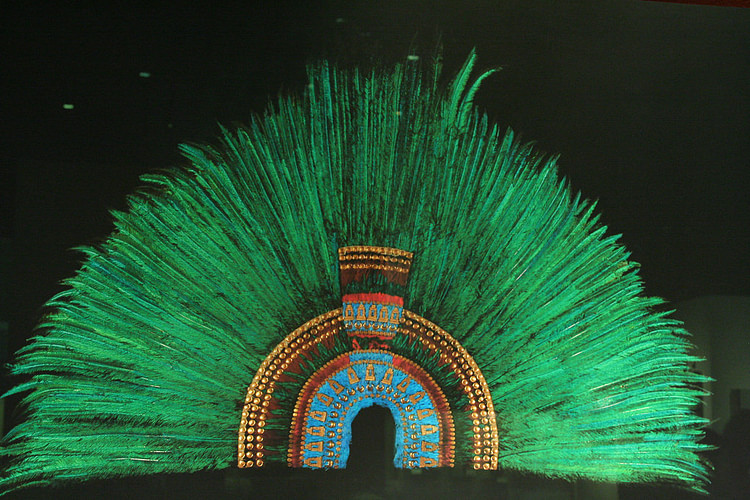
Montezuma, or more correctly, Motecuhzoma II Xocoyotzin ( aka Moctezuma ) or 'Angry Like A Lord' was the last fully independent ruler of the Aztec empire before the civilization ’s collapse at the hands of the Spanish in the early 16th century CE. Taking the position of tlatoani, meaning 'speaker', in 1502 CE he would rule as an absolute monarch until 1520 CE, during which time he expanded the empire and was considered a god by his people and a manifestation and perpetuator of the sun.
AN ABSOLUTE RULER
Motecuhzoma was the son of the great leader Axayacatl (r. 1469-1481 CE) and was one of the best warriors under his uncle Ahuitzotl (r. 1486-1502 CE). In particular, he distinguished himself in the Aztec campaigns in Tehuantepec and Xoconochco.On the death of Ahuitzotl, Motecuhzoma assumed the highest position in Aztec society and he became, in a sumptuous coronation ceremony, the undisputed religious and political leader or tlatoani in 1502 CE.
We are fortunate to have a first-hand physical description of Motecuhzoma by Bernal Diaz del Castillo, who saw him in 1519 CE:
[He was] about 40 years old, of good height and well-proportioned, slender and spare of flesh, not very swarthy, but of the natural colour and shade of an Indian. He did not wear his hair long, but so as just to cover his ears, his scanty black beard was well-shaped and thin. His face was somewhat long, but cheerful, and he had good eyes and showed in his appearance and manner both tenderness and, when necessary, gravity. (Townsend, 19)
As part of the ceremonies to confirm him in his new status Motecuhzoma led an army, in what became known as the Coronation War, to Nopallan, 640 km to the south. Conquering the fortified city he brought back to Tenochtitlan substantial booty and a contingent of captives for ritual sacrifice. The new tlatoani was also commemorated in a specially commissioned stone (now known as the Coronation Stone of Motecuhzoma II) which was covered in carvings depicting the five eras of Aztec mythology, the year sign 11-reed (1503 CE) and the day 'one alligator' (4th of June).
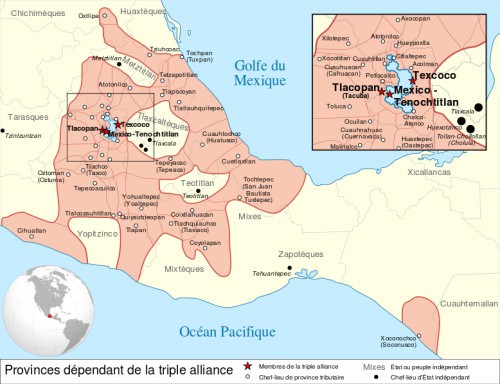
Aztec Empire
Motecuhzoma set about widening the powers of the tlatoani position by simultaneously reducing the duties of the chief of internal affairs ( Tlacaellel or Cihuacoatl) so that he became, in effect, absolute ruler and undisputed leader of the Triple Alliance of the three great cities of Tenochtitlan, Tetzcoco and Tlacopan. Motecuhzoma also elevated the status of the nobility by further differentiating them from the rest of society through an increased emphasis on titles, distinguishing clothes and insignia and etiquette at court.
MOTECUHZOMA COMMANDED, THEN, AN EMPIRE WHICH STRETCHED FROM THE NORTHERN LIMITS OF MEXICO TO TODAY'S GUATEMALA.
Motecuhzoma commanded, then, an empire which stretched from the northern limits of Mexico to today's Guatemala. Indeed, he even expanded it and fought four major wars so that only the Tarascans in the east and the Tlaxcalans in the west remained unconquered. These subject states all paid tribute as indicated in the Aztec tax records. Tribute could take the form of traditional precious materials such as gold and jade, exotic feathers and even animals such as eagles and jaguars. Tribute could also be in the form of clothes, fabrics and foodstuffs such as corn and cacao.
A LIFE OF LUXURY
Motecuhzoma certainly lived like a king. His huge palace at the Aztec capital of Tenochtitlan had hanging gardens, a ten-room aviary with fresh and salt-water pools, and even a private zoo with jaguars, eagles, pumas, foxes and snakes amongst hundreds of other exotic animals. The Aztec king was cared for by 3,000 attendants and, according to Bernal Diáz, a typical royal meal included hundreds of specially made dishes which included turkey, venison, duck, pigeon, rabbit, quail, fish and boar, all served on finely decorated and especially delicate Cholula pottery. We are also told that the king ate alone and behind a gilded screen, entertained by jugglers and acrobats.
Other snippets of information about the ill-fated king include the fact that he visited the great city of Teotihuacan several times, a pilgrimage that entailed the crossing of Lake Texcoco by canoe. That he had a fascination for dwarves, hunchbacks and albinos, all of which were kept in special chambers within the royal palace and we also know that he wore golden sandals and loved to hunt birds using a blowpipe. Finally, he was interested in the arts, astrology and philosophy.
THE BEGINNING OF THE END
Even before the Spanish arrived, all was not quite well with the Aztecs for their empire was based not on military might but existed as a loose binding of subject states run by puppet rulers who extracted the tributes mentioned above and imposed the worship of the Aztec deity Huitzilopochtli. The Aztecs, though, perhaps over-reached themselves and several outer tribes began to rebel, especially following the disastrous defeat in 1515 CE to the Tlaxcala and Huexotzingo. These insurrections across the empire were quashed but trouble was never far below the surface and, perhaps most significantly, the harsh treatment of the Tlaxcala would later make them more than willing allies of the Spanish.
Motecuhzoma seems to have had some instinct that troubled times were ahead as he gave great importance to omens such as a comet sighted in 1509 CE and he constantly consulted soothsayers for advice. Aztec mythology foretold that the present era of the 5th sun would eventually collapse just as the previous four eras had done. By 1515 CE rumours of a rapidly approaching crisis were fuelled by sightings off the coast of fantastic floating temples; the visitors from the Old World had finally come.
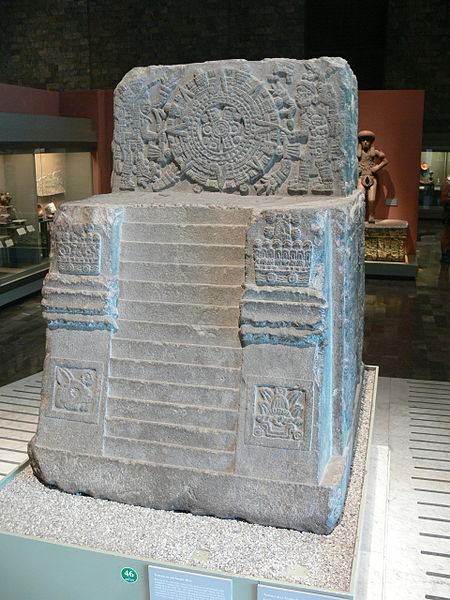
Throne of Motecuhzoma II
The Aztec leader's first strategy with the strange visitors from another world was to attempt to buy them off with gifts. These included ceremonial costumes, a massive gold disk representing the sun and an even bigger silver one representing the moon. However, if anything, this may well have further encouraged the Spanish to plunder this new land for all it was worth.
In August 1519 CE the Spanish leader Hernán Cortés marched on Tenochtitlan. According to the Spanish sources Motecuhzoma allowed them entry to the city. From here on in the history of the conflict is much debated amongst scholars and it is unlikely that the Spanish chroniclers presented a completely impartial account of events. It has been noted that it does seem strange that such a powerful ruler as Motecuhzoma should cut such a passive figure in the record of events brought down to us. However, against that it is certainly true that the Spanish had shown their military prowess and the devastating effectiveness of their superior weaponry - canons, firearms and crossbows - in quickly defeating a force of Otomi-Tlaxcalan and they also took quick and ruthless reprisals against a treacherous plot by the Cholollan. Perhaps Motecuhzoma had taken note of this and took the more prudent policy of appeasement rather than engage the enemy in the field, at least as an opening strategy.
When Cortés and Motecuhzoma finally met in person relations were initially amiable, the Spaniard was given a tour of the city and more gifts were exchanged, Cortés receiving a necklace of golden crabs and Motecuhzoma a necklace of Venetian glass strung on gold thread. Whatever Motecuhzoma had hoped to achieve through diplomacy his plans were scuppered in just two weeks when he was promptly taken hostage and placed under house arrest by the small Spanish force. Motecuhzoma was forced to declare himself a subject of Charles V, handover more treasure and even allow the placing of a crucifix on top of the Great Pyramid in the city's sacred precinct.
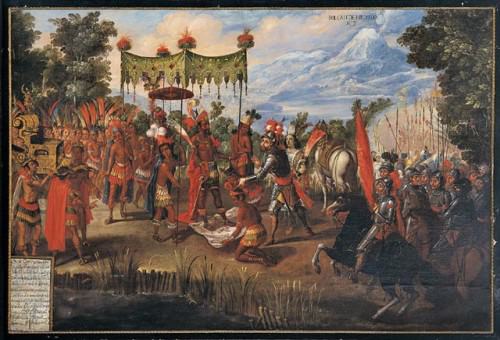
Montezuma Meets Cortes
Cortés' plans met with a setback, however, when he was forced to return to his base at Veracruz to face a rival Spanish faction. In his absence the remaining Spanish unwisely disrupted a religious ceremony involving human sacrifice and fighting broke out. The Aztec warriors, seething at the lack of decisive action renounced Motecuhzoma as their leader and Cuitlahuac was voted in as the new tlatoani. Motecuhzoma was pressed by the Spanish into pacifying his people but was struck on the head by a rock and killed.
Cortés returned to the city to relieve the besieged remaining Spanish but was forced to withdraw on the 30th June 1520 CE in what became known as the Noche Triste. He did, however, return nine months later, this time with his Tlaxcalan allies and, after a lengthy siege, the city finally fell. The Aztecs, led by Cuauhtemoc and ravaged by lack of food and disease, finally collapsed on the fateful day of 13th August 1521 CE. Tenochtitlán was ransacked of any precious goods and its monuments were destroyed. From the ashes rose the new capital of the colony of New Spain and the long line of Mesoamerican civilizations which had stretched right back to the Olmec came to a dramatic and brutal end.
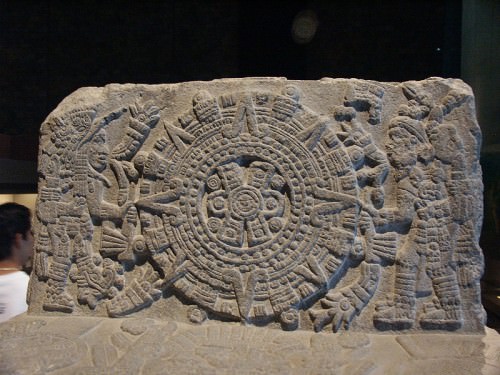
Throne of Motecuhzoma, Detail
MOTECUHZOMA IN ART
Motecuhzoma is represented in the Histories of the Indies by Dominican Diego Durán where he is seated as a statue is carved of him. We know of one particular statue which 14 sculptors worked on at Chapultepec. The Aztec ruler also appears on the stone throne known as the Teocalli Stone where he appears with a sun-disk opposite Huitzilopochtli. Also attributed to Motecuhzoma, although there is no concrete evidence to do so, is the magnificent feather headdress now in the Museum für Völkerkunde of Vienna. The headdress was probably part of the collection of artefacts given by Motecuhzoma to Cortés who passed on the gifts to Charles V. The headdress is made from 450 green quetzal, blue cotinga and pink flamingo feathers and is further embellished with gold beads and jade disks.
Cusco › Antique Origins
Definition and Origins
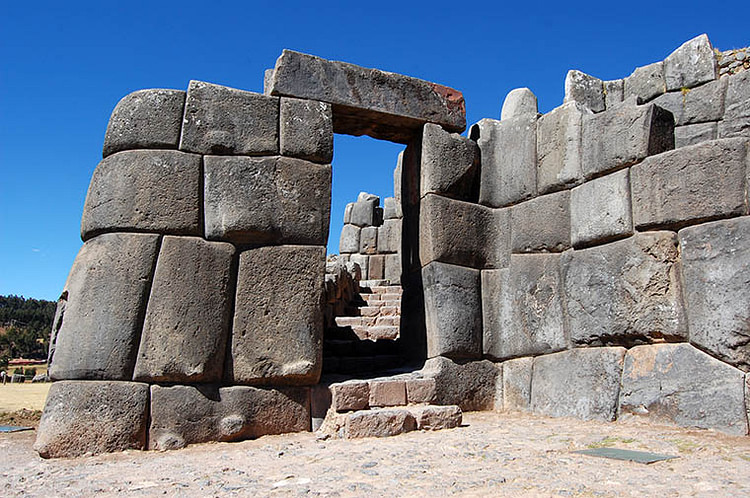
Cuzco (also Cusco or Qosqo) was the religious and administrative capital of the Inca Empire which flourished in ancient Peru between c. 1400 and 1534 CE. The Incas controlled territory from Quito to Santiago, making theirs the largest empire ever seen in the Americas and the largest in the world at that time. Cuzco, which had a population of up to 150,000 at its peak, was laid out in the form of a puma and was dominated by fine buildings and palaces, the richest of all being the sacred gold -covered and emerald-studded Coricancha complex which included a temple to the Inca sun god Inti.
CUZCO IN MYTHOLOGY
In mythology the Inca race was created by the great god Viracocha who caused them to be born from the sun god Inti. The first eight Incas were thus born at Tiwanaku or, in an alternative version, they emerged from the sacred Pacaritambo cave, and then they migrated down to the Cuzco valley. Led by Manco Capac (or Manko Qhapaq) and Mama Ocllo, the group fulfilled the earlier prophecy whereby they should settle where their golden staff could be easily driven into the ground. Before the Incas could prosper, though, they first had to defeat their local rivals, the Chanca, a feat they achieved with the help of stone giants, the pururaucas. This event did have a basis in reality, as the Incas did indeed defeat the Chanca in 1438 CE.Thus the Inca capital was established. The name Cuzco may derive from either qosqo, meaning 'dried-up lake bed' or cozco, a particular stone marker in the city.
GEOGRAPHY, LAYOUT & ARCHITECTURE
The geographical location of the site, on an ancient glacier lake bed and at a central point between natural routes leading off to diverse surrounding regions, was advantageous. The basin lies at an altitude of 3,450 metres and is surrounded by mountain peaks. Crops could be grown in the valley, and the hills provided good pasture. Cuzco is also the meeting point of three rivers - the Huatanay, Tullumayo, and Chunchul - making it especially significant and auspicious in the Inca mind. In typical Inca fashion, where nature was adapted but never abused, the rivers were canalized and diverted to create the space necessary for a large city.
CUZCO SAW A GREAT PERIOD OF RE-BUILDING IN THE MID-15TH CENTURY CE DURING THE REIGN OF PACHACUTI, KNOWN AS 'REVERSER OF THE WORLD'.
First habitation of settled populations was actually as early as 500 BCE or earlier, and the main pre-Inca settlement was Chanapata. Decorated pottery survives from this period, but there is no evidence of large buildings, artworks, or metal.Similarly, there are no remains from the Tiwanaku period at the Cuzco site itself. Cuzco really began to take shape from around 1200 CE but only took on the grandeur of a capital during the reign of Inca Roca in the 14th century CE. From that point on each Inca ruler built his own palace, a great walled residential complex. In addition, from 1400 CE the Incas embarked on ambitious campaigns to conquer neighbouring territory, eventually building a huge empire with Cuzco as the administrative and religious capital.
The city saw a great period of re-building and expansion in the mid-15th century CE during the reign of Pachacuti Inca Yupanqui, known as 'Reverser of the World'. The swamp area in the north was drained, and the heart of the city moved there.Large ceremonial plazas were laid out, the Sacsayhuaman (or Saqsawaman) fortress, which protected the north of the city, was built, and the sacred Coricancha complex was rebuilt to more appropriately reflect the wealth and power of the Inca Empire. Other building works over time, which increased the spread of Cuzco to some 40 hectares, seem to have been less deliberately planned, resulting in an irregular shaped urban area.
The whole capital was built around four principal highways which led to the four quarters of the empire. The city was also laid out in the form of a puma (although some scholars dispute this and take the description metaphorically) with the imperial metropolis of Pumachupan forming the tail, the main plaza representing the body, and the temple complex of Sacsayhuaman forming the head. The entire city was also divided into two distinct parts called the hanan and hurin; the former, in the north, was higher in elevation and more prestigious than its lower, southern, counterpart. Five noble families occupied each sector.The centre was dominated by the double plazas of Haucaypata ('Terrace of Repose') and Cusipata ('Fortunate Terrace') which, covered in imported sand, hosted religious and state ceremonies. These would be presided over by the Inca king, seated on his carved stone throne on a raised platform, the usnu, which also had a pillar for taking sightings of celestial bodies. Here there was also a giant stone basin covered in gold into which were poured libations of chicha beer. Dominating the plaza was the Sunturwasi, a spire which was the tallest structure in Cuzco.
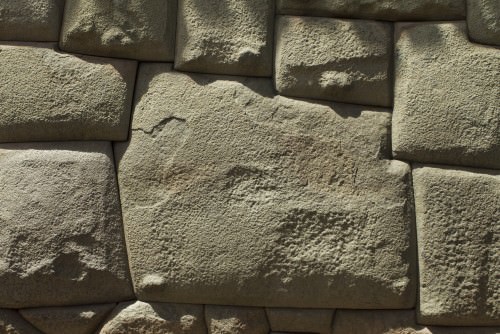
Inca 12 Angle Stone
Incorporating kanchas (small groups of buildings organised around a courtyard all within a high-walled enclosure), vast plazas, parklands, sacred agricultural fields, shrines, fountains, and canals, yet with the narrow streets of a culture without wheeled vehicles, the city was largely reserved for priests, nobility, and administrators, while the farming and artisan communities were spread out beyond Cuzco's walls where there were also hundreds of qollqa storehouses which had a huge storage capacity.The city proper had a population of around 40,000 with another 200,000 in the surrounding area at the time of the Spanish conquest.
Cuzco was also an important component in the propaganda of Inca rule. It was encouraged to be venerated by Inca subjects as a sacred site. This policy also entailed tributes both in real value objects, such as gold and artworks, but also in people, either rulers and/or their family members kept as hostages, forcibly relocated artists and skilled craftsmen and women, and the provision of sacrificial victims. In addition, radiating out from Cuzco were 41 sacred sight lines ( ceques ) and well-paved roads which divided both space and time and reminded that Cuzco was the centre of the world. Finally, small models of Cuzco have been discovered across the empire which must have spread the news of the capital's great size and wealth.
CORICANCHA
Most splendid of Cuzco's buildings was the Coricancha ( Qorikancha ), with its temples ( wasi ) built in honour of Inti, the moon goddess Mama Kilya (Quilla), the creator god Viracocha, Venus or Chaska-Qoylor, the god of thunder Illapa, and finally one for Cuichu the rainbow god. Each wasi contained a cult statue of that particular god and precious art and religious objects connected to them. The Coricancha, also known as the Golden Enclosure, was thus the most sacred of all Inca sites and considered the very centre of the world.

Coricancha
Built using the fine masonry skills for which the Inca have rightly become famous, the massive walls of the complex were built from large stone blocks finely cut and fitted together without mortar. The interior buildings were of one storey and had thatched roofs. The doors were also covered in gold sheets, as were the interiors and exteriors of the various temples, and the inner side of the perimeter wall was even said to have been studded with emeralds. The temple to Inti, also known as the Temple of the Sun, was lined with 700 2 kg sheets of beaten gold, symbolizing the sweat of the god, and Mama Kilya's temple was similarly lined with silver, symbolizing the tears of the moon.
Inside the Temple of the Sun, besides golden artefacts relevant to the god's worship, was a gold statue of Inti encrusted with jewels. The statue represented Inti as a small seated boy called Punchao (Day or Midday Sun). Another important representation of the god - a giant mask with zigzag rays bursting from the head - was hung from the wall of an especially dedicated chamber within the temple. The garden of the temple was even more spectacular. Just as land - sometimes even entire regions - were dedicated to the god, so too, this garden was constructed in honour of the great sun god. Everything in it was made of gold and silver. A large field of corn and life-size models of shepherds, llamas, jaguars, guinea pigs, monkeys, birds, and even butterflies and insects were all crafted in precious metal. And if that wasn't enough to please Inti, there was also a large number of gold and silver jars all encrusted with precious stones. All that survives of these wonders are a few golden corn stalks, a convincing, if silent, testimony to the lost treasures of Coricancha.
The Coricancha also had a dedicated space for the mummified remains of former Inca emperors and their wives, known as mallquis. These were brought out of storage during special ceremonies such as those celebrating the solstices. There were also living quarters for priests and priestesses, and still other rooms of the complex were used as art and religious treasuries stuffed with artefacts taken from conquered peoples. These may well have been kept in order to guarantee compliance to Inca rule, just as conquered rulers were sometimes held hostage at Cuzco for periods of the year. Yet another interesting feature of the site was an underground channel through which sacred water flowed to the surrounding squares outside the complex.
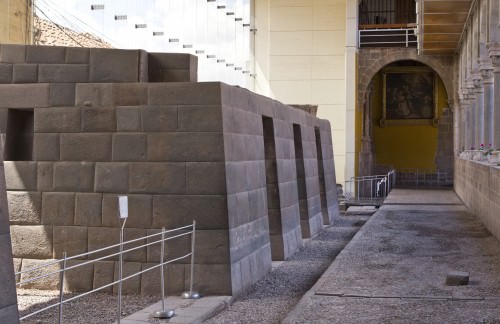
Coricancha
Other important functions of the Coricancha included the taking of astronomical observations, especially of the Milky Way (Mayu). Sacrificial victims ( capacochas ) were also made ready for their great moment in the precinct's courtyard and then marched along the ceque lines to be sacrificed in the various provinces in honour of Inti and his living incarnation, the Inca emperor.
SACSAYHUAMAN
The fortress of Sacsayhuaman, built by Pachacuti, was likely first constructed using mud and clay, later to be replaced by magnificent stone work which employed huge finely cut blocks, many weighing over 100 tons. Designed by four architects (Huallpa Rimachi, Maricanchi, Acahuana, and Calla Cunchui) and built using 20,000 tribute labourers, the structure has three terraces set in zigzag fashion so that each wall has up to 40 segments which allowed the defenders to catch attackers in a crossfire. Only one small doorway on each terrace gave access to the interior buildings and towers on the hillside behind. The fortress was said to have had a capacity for 1,000 warriors. Following the collapse of the empire, most of the stones were re-used elsewhere, and the ruins were covered in earth to prevent their use by rebel forces.
DESTRUCTION
The Incas expanded their territory to such a degree that a mere 40,000 Incas controlled an empire of 10 million subjects. The Inca Empire was founded on, and maintained by, force which made the leaders unpopular with their subjects (especially in the northern territories), a situation that the Spanish C onquistadores, led by Francisco Pizarro, would take full advantage of in the middle decades of the 16th century CE. The Inca Empire also had to face various rebellions including a war in Ecuador where a second Inca capital had been established at Quito. Even more serious, the Incas were hit by an epidemic of European diseases such as smallpox which had spread from Central America even faster than the European invaders themselves, and the wave killed a staggering 65-90% of the population. Such a disease killed Wayna Qhapaq in 1528 CE and two of his sons, Waskar and Atahualpa, battled in a damaging civil war for control of the empire just when the European treasure-hunters arrived. It was this combination of factors - a perfect storm of rebellion, disease, and invasion - which ultimately brought the downfall of Cuzco and the mighty Inca Empire.
Cuzco was sacked, its main buildings either burned and destroyed or taken to pieces for reuse in new construction projects.Thus the once golden splendour of Inca Cuzco now, unfortunately, survives only in the eye-witness accounts of the first Europeans who marvelled at its architecture and riches and the odd stretch of Inca walls, especially the precisely cut supporting walls of the Dominican monastery.
MAP
LICENSE:
Article based on information obtained from these sources:with permission from the Website Ancient History Encyclopedia
Content is available under License Creative Commons: Attribution-NonCommercial-ShareAlike 3.0 Unported. CC-BY-NC-SA License